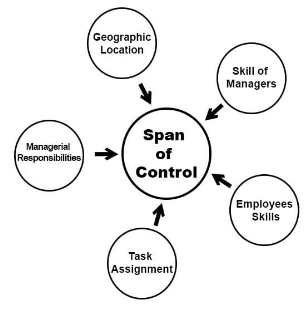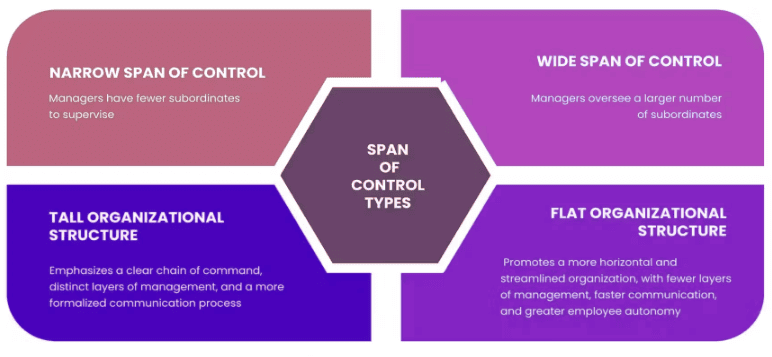Span of Control | Crash Course for UGC NET Commerce PDF Download
| Table of contents |

|
| Span of Control-Meaning |

|
| Span of Control in Management |

|
| Types of Span of Control |

|
| Factors Influencing Span of Control |

|
| Principle of Span of Control |

|
Span of Control-Meaning

- The concept of span of control arises from the idea that a manager can effectively oversee only a specific number of individuals due to limitations on time, attention, and supervision.
- Both excessively narrow and excessively wide spans of control can result in inefficiencies.
Span of Control in Management
- The span of control denotes the number of subordinates a manager can effectively lead, supervise, and nurture.
- It elucidates the breadth or narrowness of a manager's authority over direct reports.
Span of Control in Public Administration
- The span of control, or the quantity of assistants a manager can supervise, holds paramount importance in public administration to ensure efficiency, accountability, and proficient governance.
Types of Span of Control

The span of control can be categorized into two main types: narrow span of control and wide span of control.
Narrow Span of Control
In a narrow span of control, a manager oversees a small number of subordinates. This structure creates a tall organizational hierarchy with multiple management layers. While this allows for more direct supervision and control, it can also slow down decision-making and communication.
Characteristics:
- More hierarchical levels.
- Closer supervision.
- Clearer communication channels.
- Slower decision-making.
Advantages:
- Enhanced supervision and guidance.
- Clearer lines of communication.
- Specialized roles and expertise.
Disadvantages:
- Slower decision-making.
- Increased workload for managers.
- Potential for rigidity in the organization.
Wide Span of Control
In a wide span of control, a manager supervises a larger number of subordinates, leading to a flatter organizational structure with fewer management layers. This setup can lead to quicker decision-making and increased flexibility, but it may also result in challenges with supervision and coordination.
Characteristics:
- Fewer hierarchical levels.
- Greater autonomy for employees.
- Faster decision-making.
- Potentially weaker supervision.
Advantages:
- Quicker decision-making.
- More efficient resource use.
- Greater flexibility and adaptability.
Disadvantages:
- Weaker supervision.
- Limited direct guidance.
- Possible communication challenges.
The ideal span of control depends on factors such as the nature of the work, employee competence, task complexity, and the organization’s culture. There is no universal solution, and organizations may use different spans of control in different areas of their structure.
Factors Influencing Span of Control
Several factors impact the appropriate span of control:
- Nature of Work: Complex tasks that need close oversight typically favor a narrower span of control, while routine or repetitive tasks can be managed with a wider span.
- Employee Skills and Experience: Highly skilled and experienced employees require less supervision, allowing for a wider span of control. Conversely, less experienced or less skilled employees need more guidance, suggesting a narrower span.
- Level of Technology Use: Advanced technology, such as project management and collaboration tools, can enable managers to oversee more employees effectively, supporting a wider span of control.
- Management Style: Managers who adopt a participative style and delegate decision-making authority usually have narrower spans of control. Directive managers who maintain tight control often manage a wider span.
- Degree of Centralization: Decentralized organizations, which delegate decision-making authority, tend to have wider spans of control as decisions are made at lower levels. Centralized organizations, with concentrated power at the top, generally favor narrower spans.
- Organizational Goals: The span of control should align with the organization's goals for efficiency. This can result in either narrow or wide spans, depending on what best supports achieving these goals.
- Availability and Costs of Managers: To manage costs, organizations may prefer wider spans of control to reduce the number of managerial layers and expenses.
Principle of Span of Control
The principle of span of control outlines that:
- Managers have a finite capacity to effectively oversee a number of subordinates due to limitations in time, energy, and attention.
- Both excessively narrow and wide spans have drawbacks. A moderate span offers a balance between efficiency, supervision, and motivation.
- The optimal span varies according to factors such as work complexity, employee skills, management style, and technology use. There is no universal span that fits all situations.
- An ideal span allows managers to effectively delegate, monitor, address issues, and support employee development.
- For employees, a balanced span ensures adequate guidance, feedback, and support from managers, enhancing performance.
- For organizations, the right span of control aids in achieving goals efficiently. Narrow spans may increase costs, while wide spans can reduce supervision and morale.
- The span of control affects organizational structure and authority lines, impacting performance, job satisfaction, and cost-effectiveness.
- Determining the optimal span involves evaluating both managerial capabilities and situational requirements to balance supervision, motivation, and productivity.
Conclusion
Span of control refers to the number of subordinates a manager can effectively oversee and develop. An optimal span balances managerial needs with those of employees and the organization. Identifying the right span requires considering factors such as task complexity, employee skills, and management style. The span of control influences organizational structure and authority, aiming to maximize performance, motivation, and cost-efficiency while accommodating managers' capacities.
|
157 videos|236 docs|166 tests
|
FAQs on Span of Control - Crash Course for UGC NET Commerce
| 1. What are the factors that affect the span of control in an organization? |  |
| 2. How does the nature of work impact the span of control in an organization? |  |
| 3. How does the level of skill of subordinates affect the span of control? |  |
| 4. How does centralization influence the span of control in an organization? |  |
| 5. How does the use of technology impact the span of control in an organization? |  |




















